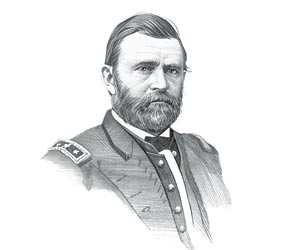|
|
|
|
|
Oakes Ames, a member of the House of Representatives from Massachusetts, was also the head of a company called the "Credit Mobilier" which had been formed to build the Union Pacific Railway. Fearing that Congress would pass laws that might hurt the enterprise, Oakes Ames gave stock in the company to other members of Congress. Despite the inquiry nothing definite could be proved against any members, and the matter dropped.
Credit Mobilier Scandal History for kids: President Grant and the Scandals of his
Administration
Credit Mobilier Scandal Facts for kids The Union Pacific Railroad and the construction company were involved in the building of the eastern portion of the First Transcontinental Railroad. The story erupted in 1872 although its scandal's origins dated back to 1864 during the Lincoln presidency, when the Union Pacific Railroad was chartered by the federal government and the Credit Mobilier construction company was established. Oakes Ames, was a member of the House of Representatives from Massachusetts, and was also the head of a company called the "Credit Mobilier". The company had been formed to build the Union Pacific Railroad. The federal government had granted the railroad generous loans and contracts for its construction It later emerged that the building of the transcontinental railroad was fraudulently financed for approximately $50 million more than was necessary. Oakes Ames was scared that Congress would investigate the finances of the company or pass laws that might hurt the construction enterprise, In 1868 Congressman Oakes Ames had distributed shares of stock in the construction company and cash bribes to other congressmen during the Johnson presidency. Rumors surrounding the activities of Oakes Ames and other prominent government officials started to circulate Oakes Ames wrote a letter to Colonel Henry S. McComb, another railroad entrepreneur and associate, stating that he had placed the stock "where it will produce the most good to us" and Ames subsequently forwarded a list of Congressmen who had received or were to receive shares. Ames and McComb then fell out. McComb leaked the letters to Charles A. Dana a newspaper owner. The story was eventually broken by the Sun, the New York newspaper owned by Charles A. Dana, during the 1872 presidential campaign, when Ulysses S. Grant was running for re-election. The story became an issue of the presidential campaign The story was a political 'hot potato' and the names of the other officials started to be implicated in the allegations of bribery and corruption. The important and influential men implicated in the allegations of bribery and corruption included:
In 1872 the Senate started and investigation into the story and the politicians who had been implicated. The investigation ended in 1873 and found that found that the company had given shares to more than thirty representatives of both political parties Only two politicians were publicly censured: Oakes Ames, the member of the House of Representatives from Massachusetts and Congressional Representative James Brooks of New York Ames and Brooks were censured for using their political influence for personal financial gain On February 28, 1873 James Brooks was censured by the House of Representatives for attempted bribery On February 28, 1873, the House passed a resolution formally censuring Ames "in seeking to secure congressional attention to the affairs of a corporation in which he was interested, and whose interest directly depended upon the legislation of Congress, by inducing members of Congress to invest in the stocks of said corporation." The punishment of Ames and Brooks was incredibly lenient, there were no prosecutions, they basically recieved a public 'slapped wrist" |
| US American History |
| 1866-1881: Reconstruction Era |
|
|
|
|
|
First Published2016-04-19 | |||
|
Updated 2018-01-01 |
Publisher
Siteseen Limited
| ||
|
|

